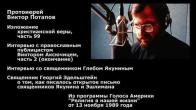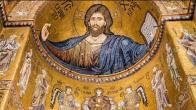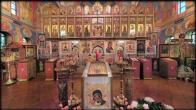You are here
The Foundations of Our Orthodox Faith: A Discourse on the Sunday of Orthodoxy

The essential feature of our Orthodoxy is that, for it, Christianity is not a theory, but rather the very life in Christ, following the precepts of the Gospel and the determinations of the Church.
ARCHIMANDRITE JOHN KRESTIANKIN (+2006) | 03 MARCH 2012
This is the faith of the Apostles, this is the faith of the Fathers, this is the faith of the Orthodox, this is the faith which has established the universe.
Why is it that we love Orthodoxy and the Orthodox Church? In the days of His earthly life, pious listeners, our Lord Jesus Christ united around Himself all who believed in Him, and among these believers He drew the Apostles particularly close to Him.
The Church of Christ began to take shape on the day of Holy Pentecost from the people who believed in Christ, with the Apostles becoming the first leaders of this Church, its pastors and teachers.
Their task was not an easy one. Not only did they have to teach the true faith to, and spiritually strengthen, those who had accepted Christianity, but they also had to guard simultaneously against false teachings and heresies. In the words of the Apostle, these heresies “must be” in order to make manifest “those who are approved” (cf. 1 Corinthians 11:10), that is, the more right-believing and firm among those who believe in Christ. The victory of Orthodoxy was secured by the decrees of the Ecumenical and Local Councils.
Since that time, the Church of Christ also has the universal Symbol of Faith that we hear in our churches at every Divine Liturgy.
Since the year 842, the Holy Church has proclaimed this Symbol with particular solemnity on the day of the Triumph of Orthodoxy, that is, in today’s special rite, with these words: “This is the faith of the Apostles, this is the faith of the Fathers, this is the faith of the Orthodox, this is the faith which has established the universe.”
Pious listeners! Our faith is called Apostolic because it has preserved wholly and inviolably everything that Christ Himself and His Apostles taught and that is contained in Holy Scripture and Holy Tradition.
This holy faith was honored and defended by the Church Councils and by the works of the Holy Fathers and teachers of the Church. By it were the Holy Fathers saved and glorified. Therefore it is also called the faith of the Fathers.
Because it is genuinely true and salvific, granting us grace-filled power “unto life and piety” [2 Peter 1:3], it is also called right-believing or Orthodox.
As you see, brothers and sisters, our Orthodoxy is established upon a sound and inviolable foundation: fidelity to the teaching of the Savior, the Apostles, the Holy Fathers of the Ecumenical Councils, and the age-old experience of the spiritual and grace-filled life in Christ. The hosts of holy God-pleasers – martyrs, confessors, wonderworkers, holy monastics, and other saints – witness by their God-pleasing lives and righteous deaths to the truth and salvific nature of the Orthodox faith.
All our pious ancestors were saved by this faith, bequeathing this faith to us to preserve as the apple of our eye and to be saved by it. Our faith is also called Orthodox to distinguish it from the faith of Catholics and Protestants, who have deviated from the single trunk of the faith of the Apostles, the Fathers, and the Orthodox.
The essential feature of our Orthodoxy is that, for it, Christianity is not a theory, but rather the very life in Christ, following the precepts of the Gospel and the determinations of the Church.
The foundation of this faith is heartfelt, deep, and living faith in the Living Tri-hypostatic God – the Creator of heaven and earth, Everywhere-present, All-Seeing, All-Merciful – Who is always ready to accuse us (through the reproaches of our conscience), to come to our aid (through our prayer), and to bestow the grace of love and forgiveness (through the Mysteries).
The second foundation of our Orthodoxy is faith in Jesus Christ as the Son of God and Redeemer of the world. Faith that He, along with the Holy Spirit (and not without the participation of the Heavenly Father), summons, sanctifies, illuminates, and enlightens us for salvation, uniting with us in the Mystery of Holy Communion.
The third foundation of our Orthodox faith is faith in the future afterlife, in the unity of the earthly and heavenly Church, and in the intercession of the Mother of God and all the God-pleasers for us.
The fourth foundation is our Christian love, brotherhood, and mercy for one another, as members of one family and one body: the Church of Christ.
The fifth foundation is the Church of Christ itself, its Holy Tradition, its establishments and divine services: the Mysteries, rites, works of the Holy Fathers, decrees and rules of the Universal and Local Councils, and the entire centuries-long grace-filled experience of life in Christ and its guidance to salvation of its faithful children. The founding power of the Church is the Holy Spirit living in it since the day of Pentecost. All of us, brothers and sisters, would do well to check ourselves from time to time to see if we are Orthodox and to see if we are fulfilling the requirements established by our Mother Church.
Let us dwell somewhat more specifically on the meaning of the Holy Orthodox Church for us and for our salvation. Look at how it (the Orthodox Church) helps us in our salvation. It sanctifies our coming into the world through the Mystery of Baptism and it accompanies us through life with the grace-filled gifts of the other Mysteries and prayers. It bids us farewell into the other world with its marvelous hymns, the prayers of absolution, and blessings. Our entire lives – from cradle to grave – take place under its holy guidance and blessing. Its significance is especially apparent in common prayer (in church) and in the guidance of our spiritual lives.
It is the Church that grandly adorns our wondrous churches with holy icons, disposing us to the prayerful lifting up of our souls and hearts to the Lord God. It is it that sweetens, spiritually nourishes, and seizes our souls with the profound meaning and order of its divine services. It is it that sanctifies and strengthens through the grace of its prayers and Mysteries our weak and orphaned souls.
It is it that allocates for us each week particular days (Wednesdays and Fridays) for fasting and repentance. Over the course of the year it allocates special times, four fasts, for the same purpose.
You see that a week has already past since we entered the days of the Holy Forty Day Fast.
The Orthodox Church does everything to make our soul tremble and shutter during these great and holy days, to make it feel the filth of its sinfulness, and to ignite a thirst for purification, renewal, and sanctification.
The Holy Church, through its penitential Lenten services – with their moving melodies, prayers, and bows – calls us to repentance and reconciliation with God. At no other time is the Lord as close to our sorrowful souls and suffering consciences, “knocking” at our hearts (cf. Revelation 3:20), as during precisely these holy days.
We all know that only by spending Great Lent strictly, only by purifying and sanctifying our souls through repentance, will we be able to greet the Paschal night joyfully and solemnly, when our renewed and resurrected souls will, with the entire universe, triumphantly sing hymns to the Risen Savior, not knowing where we are, whether in heaven or on earth.
Who makes and creates this ineffable blessedness and heavenly joy for us? It is our Orthodox Church alone, which bears and preserves our Orthodoxy.
Let us, then, beloved brothers and sister, preserve our Orthodoxy, just as our pious ancestors did, let us live and be saved, bearing honorably the great name of Orthodox Christians. Amen.
Translated from Russian.
Relics in cathedral - monthly calendar
| S | M | T | W | T | F | S |
|---|---|---|---|---|---|---|
|
|
|
|
|
|
1
|
2
|
|
3
|
4
|
5
|
6
|
7
|
8
|
9
|
|
10
|
11
|
12
|
13
|
14
|
15
|
16
|
|
17
|
18
|
19
|
20
|
21
|
22
|
23
|
|
24
|
25
|
26
|
27
|
28
|
29
|
30
|
PARISH LIFE
Address of our Cathedral
While all the materials on this site are copyrighted, you may use them freely as long as you treat them
with respect and provide attribution on the Russian Orthodox Cathedral of St.John the Baptist of Washington DC.









